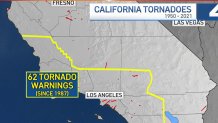After a small tornado touched down in Montebello, tearing up the roof of a building and sending debris swirling, some might be questioning why Los Angeles doesn't see stronger tornadoes now that we know they can happen here.
Meteorologist David Biggar and National Weather Service expert Ariel Cohen explain why that is, and reveal that there have been a lot more reports of tornadoes in LA versus other areas, like Northern California.
On Tuesday night, a weak tornado touched down in Carpinteria damaging 25 mobile home units before a small tornado ripped parts of a roof off a building in Montebello Wednesday.
Get top local stories in Southern California delivered to you every morning. >Sign up for NBC LA's News Headlines newsletter.
Cohen, who holds a Ph.D. in Meteorology and had studied storm prediction and severe weather, explained that essentially it boils down to topography and the types of storms the region experiences next to the Pacific Ocean.
What is a tornado?
A tornado is described by the NWS as a "violently rotating column of air touching the ground," in which winds can reach up to 300 mph.
What is the Enhanced Fujita Scale?

The Enhanced Fujita Scale (EF Scale) is used to look at damage indicators after a tornado has touched down.
The National Weather Service looks at the degree of damage to roofs, awnings, or other damaged property and how it corresponds to the EF scale.
It is not meant to measure how strong a tornado is, but rate how strong it was based on damage.
Landspout vs. Tornado: What's the difference?
A landspout technically is a tornado, NWS said.
Landspouts and waterspouts typically cause less damage than a tornado.
A tornado forms when a rotating updraft of wind, where two winds at two different levels blow at different speeds or directions.
"An invisible 'tube' of air begins to rotate horizontally. Rising air within the thunderstorm tilts the rotating air from horizontal to vertical – now the area of rotation extends through much of the storm. Once the updraft is rotating and being fed by warm, moist air flowing in at ground level, a tornado can form. There are many ideas about this too," the NWS says on its site.
There are also non-supercell tornadoes that are shorter and weaker. A landspout is a non-supercell tornado.
With a landspout, there is no air spinning up from the ground. Damage from these spouts are an EF2 or lesser on the Fujita Scale, according to the NWS.
Tornadoes in LA and Southern California

Since 1950, there have been 467 reported tornado events across California, according to the National Oceanic and Atmospheric Administration.
By far, the greatest number of tornadoes that have been reported hit in LA County, at 45 reported events.
- Los Angeles: 45
- San Bernardino: 33
- Orange: 31
- Ventura: 7
In the Midwest, thunderstorms can reach up to 60,000-70,000 feet, whereas in LA, there are low-top storms, NBCLA meteorologist David Biggar said.
"For our region, a lot of it is topography driven," Biggar said. "We just have smaller and weaker cells compared to the Midwest."
Cohen said a lot of areas east of the Rockies experience moisture from the Gulf of Mexico, which is a warm basin of water. The moisture goes north, and creates instability, driving a thunderstorm updraft that can rotate.
"Occasionally we do get stronger tornadoes in California, if the storm system is strong enough…so we want people to be weather ready," Cohen said.
In LA in particular compared to other California regions, the LA basin's topography creates favorable setup for a combination of enhanced spin in the lower atmosphere and enough moisture from Pacific waters, which enhances the potential for tornadoes in LA.
Reporting is another factor. In a densely populated area like LA, there are people around to witness tornadoes, as opposed to more rural areas.
Tornadoes are rare, but not unprecedented in Southern California.
The damaging winds followed a day of severe weather that included a tornado warning Tuesday night for central Ventura County and southwestern Los Angeles County. The system was expected to move out late Wednesday, but not before another wave of scattered showers.
Forty years ago to the month, a tornado packing winds between 113 and 157 mph swept through neighborhoods south of downtown Los Angeles, destroying homes and businesses, flipping cars, hurling debris and ripping part of the roof from the LA Convention Center. Nine people were killed. More than 150 buildings were damaged or destroyed. More than 30 people were injured.
When a tornado warning is issued, anyone in the warning area is advised to move to a basement -- if you happen to have one -- or interior room on the lowest floor of a building. Stay away from windows.
If you're outdoors or in a mobile home or car, it's best to find more substantial shelter and protection from flying debris.



